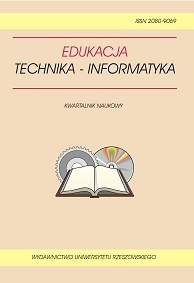Using the Method of the Concept Map in Higher Education of Adults
DOI:
https://doi.org/10.15584/eti.2018.4.47Słowa kluczowe:
teaching, learning, education, student, teacher, mental map, concept mapAbstrakt
The variability of university education is influenced, among other things, by the fact that in addition to students at the initial stage of their education, teachers also educate professionally active adults. They should, therefore, know which teaching methods can be successfully used for the education of undergraduates and of professionally active learners, and when these two pedagogical situations differ so significantly that they need to be treated differently. In this spirit, it is also necessary to approach the choice of teaching methods. During our course of Engineering Education (designed for academics wishing to acquire or extend their pedagogical skills) the method of concept maps has proven itself. In our research, we investigated whether the teachers perceived the education (in the subjects of Pedagogy, Didactics, Psychology) in which the concept map method was used as more effective in terms of remembering the subject, understanding it and applying it in their own pedagogical activities in comparison to the method of lecture with presentation.Pobrania
Opublikowane
2018-12-15
Jak cytować
MALČÍK, M., MIKLOŠÍKOVÁ, M., & SIKOROVÁ, Z. (2018). Using the Method of the Concept Map in Higher Education of Adults. Journal of Education, Technology and Computer Science, 26(4), 327–333. https://doi.org/10.15584/eti.2018.4.47
Numer
Dział
WYBRANE PROBLEMY EDUKACJI ZAWODOWEJ
Licencja
Prawa autorskie (c) 2018 Journal of Education, Technology and Computer Science

Utwór dostępny jest na licencji Creative Commons Uznanie autorstwa – Na tych samych warunkach 4.0 Miedzynarodowe.

